How to overwinter succulents
Each year Brandon gardener Gwen Beam decorates her garden with beautiful succulent art, creating new designs every year.
From living succulent picture frames that she displays on outside walls to stone head planters that grace pedestals or a repurposed stone bath, her elaborate designs feature a mix of hardy and tender succulents.
In fall, she removes the hardy succulents — mostly Sempervivum (hens and chicks) and plants them in her garden to be reused the following year.
“I bring all the succulents that are not hardy indoors for the winter,” says Beam. “I pack the tender succulents tightly into a tray with a bit of soil and put the tray under grow lights.
“I water them only once a month and do not add any fertilizer until March.”

Gwen Beam’s creative succulent display. (Gwen Beam photo)
How did Beam create her design for the stone head planter?
“The thrilling part is hunting for the plants I will use to design the head. I use some of the succulents from the previous year’s design, but always look for something new and different.
“I start with two stone bird baths which have cracks in them. I put them together and then place the stone head in the centre.
“A small amount of soil is placed around the bird baths — just enough to hold in place the succulents I will be using. I use soilless potting mix and add a bit of Sea Soil. This helps to provide moisture and nutrients to the plants all season. No fertilizer is required. I water once a month if needed.”
Fun fact: Beam is an avid gardener who grows a wide range of plants, including edibles, in her garden. An active member of the Brandon Garden Club, where she has volunteered for 40 years, one of Beam’s favourite passions besides gardening is fishing!
How to overwinter tender roses
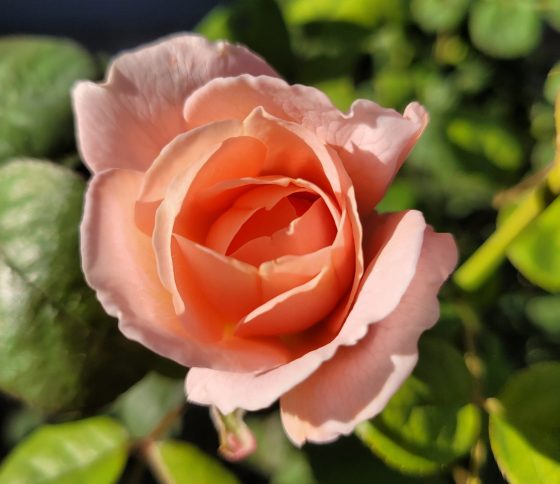
The Queen of Sweden David Austin rose (James Smith photo)
James and Gwen Smith planted Queen of Sweden David Austin rose, which has apricot pink blooms and Angel Face floribunda rose, which has lavender clusters of blossoms in their Steinbach area garden this year.
Queen of Sweden David Austin rose is hardy to zone 4 and Angel Face rose is hardy to zone 5.
They are wondering if their new roses should be cut back this fall, and how to safely overwinter the roses for the winter.
Generally, spring is a good time to cut roses back by one-third to one-half. In the case of a hardy rose exposed to the winter elements, it’s a good idea to cut back any extra-long canes to keep them from whipping around in strong winds, which can damage the entire stem.
But tender roses such as Queen of Sweden and Angel Face should not be left exposed for the winter. Here’s how to keep them safe:
- Secure a wire cage made from sturdy hardware cloth fencing around each of your tender roses, ensuring that the cages are fastened to the ground with wire clips.
- Fill the inside of each cage with a deep layer of mulch (shredded leaves, shredded bark chips, or straw), taking care to gently push down the leaves so there aren’t any empty spaces. Fill the cage all the way to the top so that the mulch covers the tender rose.
- Wrap a piece of burlap all the way around the outside of the wire cage, including the top. During the winter, shovel snow around the burlap to provide more insulation.
- Remove the burlap and mulch in spring when temperatures are consistently zero or a few degrees above zero and there is no longer a risk of a deep freeze.
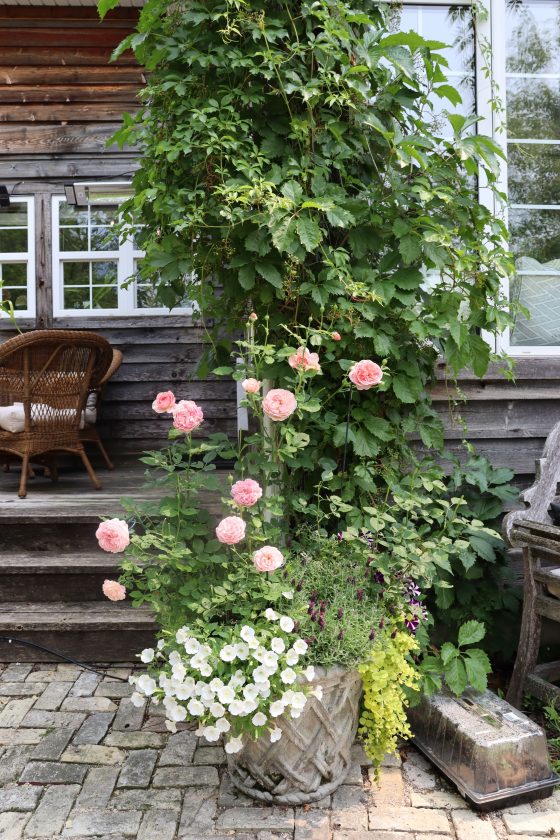
Tender David Austin roses planted in a container after being successfully overwintered in the ground. (John Tinkler photo)
I reached out to John Tinkler, who grew David Austin roses in containers in his Winnipeg garden in 2024, about his experience with overwintering.
“I planted the David Austin roses in the ground at the end of last summer and put about 10 inches (25.4 cm) of straw mulch on top,” says Tinkler. “They came through the winter fine and flowered again this year. Instead of transferring them to pots again, I left them in the ground. Fingers crossed that they survive another winter.”
Best-ever party favour: a tasty gift from the garden
Last month, when I attended the 100th birthday party for Marion Lewis, she had a present for me: a jar of homemade pear, lemon and ginger preserves.
Lewis’s mouth-watering recipe is made with pears harvested from the Ure pear trees that she planted on her river property south of St. Norbert, where she has lived since 1968.
Over the decades, Lewis, a pioneer in medical genetics, has planted numerous fruit trees, including apple, pear, cherry, and plum cultivars. As recently as five years ago, Lewis added more fruit trees to her small fruit orchard.
Lewis’s pear, lemon and ginger preserves are delicious enough to eat directly from the jar (I do). I also enjoy them with a slice of cheese on a toasted, buttered scone.
Do you grow pears in your backyard? You will want to try this recipe!
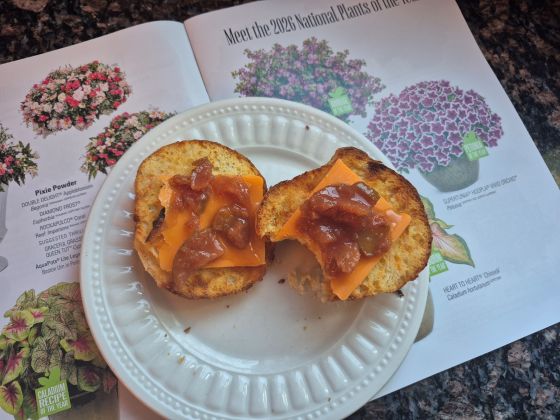
Homemade pear lemon and ginger preserves with cheese on a toasted scone. (Colleen Zacharias photo)
Marion Lewis’s lemon, pear and ginger preserves
- 10 cups (1300 to 1400 grams) sliced pears
- 6 cups (1200 grams) sugar
- 2 lemons, grated rind and juice
- ¼ cup (50 grams) preserved or candied ginger
Directions:
Place sliced pears in preserving kettle in alternate layers with sugar, lemon rind and juice.
Let stand for two to three hours.
Add ginger and bring the mixture to a boil.
Continue boiling in an uncovered pot, stirring frequently for about 45 minutes until the mixture is thick and clear.
Yields about six cups (2100 grams).
Pour into hot, sterilized jars. Cool slightly before sealing.
Beneath the pines
Want to grow plants under a pine tree? Start now by enriching the soil.
Growing plants beneath a pine tree can be challenging.
Large tree roots can make uniform planting difficult. Newly installed plants must compete for every drop of moisture and nutrients. As well, deep shade does not support healthy growth in plants that need at least a few hours of sunlight.
But if you really desire a thriving perennial bed beneath your pine tree, fall is the ideal time to nourish the soil by covering it with a thick layer (15 cm) of shredded leaves. Better yet, mix compost into the leaves for a nutrient-rich mulch.

Epimedium Bishop’s Hat works well for a shady bed beneath a pine tree. (Colleen Zacharias photo)
I collect leaves every fall for mulching a spacious bed I am slowly creating beneath three pine trees, and I swear by the results. Leaf mulch has transformed the once heavy, unworkable clay to rich soil that is easy to plant into.
Shredded leaves decompose faster than whole leaves. I love my Ryobi 40V Vac Attack Leaf Mulcher because it shreds leaves into very small pieces.
In spring, I plant directly into the decomposed organic matter.
It’s important to remember you must repeat the regimen of adding organic matter to the soil surface every fall if you want a healthy garden beneath pine trees.
Keep in mind, though, that despite the moisture-retaining benefits of organic mulch, you have to provide supplemental moisture regularly during the hot, dry summer months to a planting bed beneath pine trees — that’s an unavoidable reality to growing plants in a competitive environment. You may also need to remove some of the lower branches on your tree to ensure adequate light can reach your plants.
Typha, a soil and mulch amendment, is another organic option for amending the soil beneath pine trees. Typha is made from harvested cattail stalks that have been dried and processed.
I haven’t tried it in my garden. But I asked Alec Massé, co-founder of Typha Co., about Typha’s potential for remediating soil beneath a pine tree.
“We have seen instances where Typha has been helpful in raising the pH in soil beneath a pine tree,” said Massé. “It would also be helpful in adding a bit more nitrogen and addressing soil degradation.”
Typha is a locally made mulch and soil builder. It is available at garden centres throughout Winnipeg. All that is needed is a 2.54 to 5.08 cm layer applied to the soil surface.
Many types of shade plants can thrive beneath a pine tree once the soil has been enriched. My favourites include: Aralia cordata Sun King, Brunnera macrophylla, Epimedium Bishop’s Hat, Athyrium Lady in Red fern, Hosta Fire Island, and Pulmonarium lungwort.
Where can I find this plant?
A recent article in Fine Gardening magazine (Issue 223) featured Vernonia Summer’s End Ironweed, a new introduction by Plants Nouveau.

Vernonia Summer’s End Ironweed (Plants Nouveau photo)
Listed as one of the best new plants for 2025 (and the best ironweed hybrid to date), Summer’s End Ironweed is a late-blooming, drought-tolerant plant that attracts butterflies and pollinators.
Derived from a controlled cross at Chicago Botanic Garden, Summer’s End Ironweed exhibited a desirable uniform, upright habit and superior performance in several years of evaluation. It grows to a mature height of approximately one metre.

Lenore Linton’s New York Ironweed, planted from seed 10 years ago. (Lenore Linton photo)
Lenore Linton wants this new ironweed and asked me where she can find it. Currently, Linton grows New York ironweed in her St. Vital garden.
“I planted the seed years ago in a container before planting out in spring. I moved it from its original spot about 10 years ago. It blooms in fall. Bees and butterflies love it.”
New York ironweed (Vernonia noveboracensis) has deep purple flowers.
I reached out to Monrovia, which collaborates with Plants Nouveau, to ask about the availability of Summer’s End Ironweed.
A spokesperson said that Summer’s End is fairly new and is not yet readily available. She suggested another selection, Vernonia Summer’s Swan Song.
The fact is, ironweed is not readily available at our local garden centres, regardless of the cultivar. Plugs can sometimes be obtained though, from local native nurseries.
Another option is to lobby your local garden centre to bring in new plant introductions next spring that your heart desires. I do this all the time, and sometimes, I get what I want!
This plant can grow just about anywhere
What grows outdoors in sun or shade, thrives in the ground or in containers, can also be grown as a houseplant, and has bulbs that you can lift in the fall and store for the winter?

Heart to Heart Chinook Caladium (Proven Winners photo)
Heart to Heart Caladiums from Proven Winners are surprisingly versatile. At last count, the series includes no fewer than 31 varieties in an eclectic mix of foliage colours.
In late June, when I needed one last container for a shady location in my garden, I hastily combined three Heart to Heart White Star caladium plants with coral bells, ivy, and begonias in a large moss-lined container. I really didn’t give the design a lot of thought — perhaps I was even skeptical about how well the caladium would stand up to summer’s heat.
Well, you could have knocked me over with a fern frond.
Neither blistering heat, gale force winds, the rare rainstorm, nor occasional neglect diminished Caladium’s performance throughout the long, hot summer. I’m sold.
Heart to Heart Chinook is Proven Winners’ 2026 Caladium of the Year. Chinook features a warm combination of salmon pink colour with green edging. Suitable for sun or shade.
But if you prefer something on the moodier side, Heart to Heart Midnight Oil, new for 2026, is a different beast altogether with charcoal black foliage that develops red and green tones in autumn.
Caladium costs more than a typical annual in a 4.5-inch nursery pot. I paid about $14 for a good-sized plant in a six-inch container.
The tubers of Heart to Heart Caladium, however, can be lifted and stored for the winter. Check out a step-by-step video here.
Garden club news
On July 12, the Charleswood Garden Club organized a sold-out bus tour to Altona to visit the incomparable sculpture garden created by Todd Braun, a renowned stone carver.
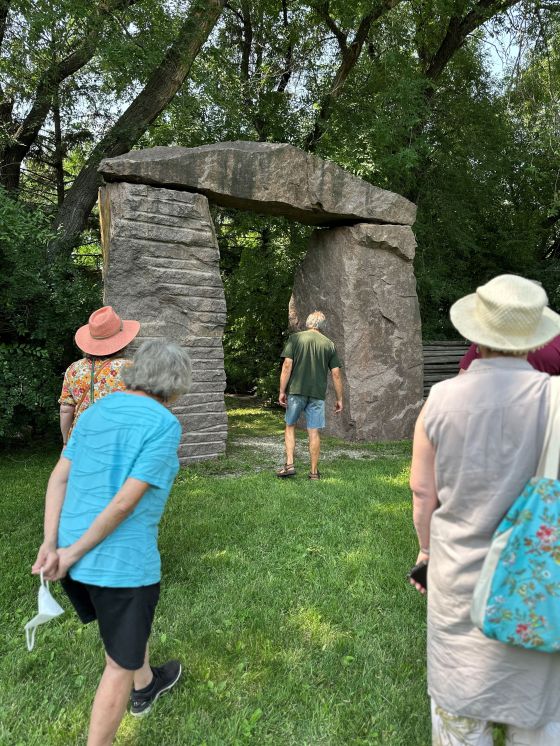
The Charleswood Garden Club took a July bus tour to stone carver Todd Braun’s Altona property. (Brenda Bacon photo)
“We had a really successful bus tour,” says Brenda Bacon. “Everyone was so impressed with Todd Braun’s place. I think it should be on a Top 10 list of Manitoba sites people should see.”

Gardening enthusiasts tour Todd Braun’s outdoor geological museum in Altona (Brenda Bacon photo)
In addition to numerous outdoor garden rooms that feature Braun’s stone carvings, his newest project is an expansive outdoor geological museum featuring stone specimens collected from around the world.
Stay tuned: I have it on good authority that another local garden club has plans for a bus tour to visit Todd Braun’s sculpture garden in 2026.
On Aug. 21, the Miami Horticultural Club celebrated 135 years with a Flower and Garden Show held at the Miami Community Club. The first flower show by the Miami Horticultural Club was hosted by Eva Campbell on her lawn in 1890.

Miami Horticultural Club members, from left: Joan Mikolasek, Shirley Zacharias, Gail Snider, Dulcie Kennedy, Lynda Oakes. (Linda Wall photo)
“We had a total of 72 exhibitors this year, including 36 adult and 36 junior exhibitors, giving us 607 entries,” says Lynn Sprott. “Our junior section was outstanding with 298 entries — the most we ever had. Our Junior Garden Club has 17 members from ages four to nine. Our most senior member, Mrs. Velma Orchard, 98, entered several lovely exhibits.”
This year’s show welcomed 155 visitors from 12 different communities, including Winnipeg.
Growing season gets rave reviews from local flower gardener
Don Edward Wijesuriya is thrilled with the performance of his flower garden this year.
“All the flowers were so colourful and beautiful,” he says. He planted more than 400 annuals from seeds collected by his wife, Malani Yapa Bndara.
“We both love nature and that’s the reason we spend so many hours in the garden. So many people take pictures of the flowers almost every day. The sad part is, summer has already ended.”
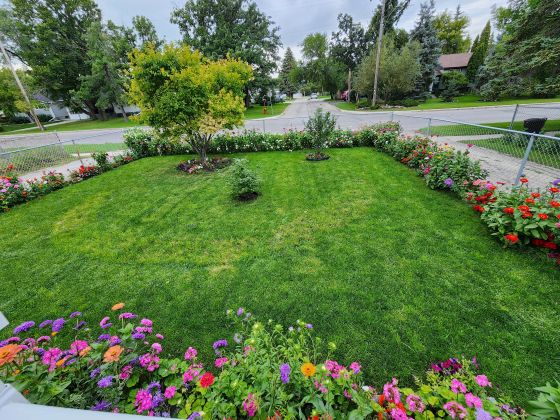
Don Edward Wijesuriya’s flower garden with 400 annuals grown from seed. (Don Edward Wijesuriya photo)
Must-see virtual garden tours
Take a virtual and breathtaking stroll through Kildonan Park.
This past summer, Winnipeg gardener Alyssa Rempel created a wonderful video of the North Garden in Kildonan Park. You’ll want to take a visual walk along the curved paths at Kildonan Park and admire the stunning flower arrangements again and again.
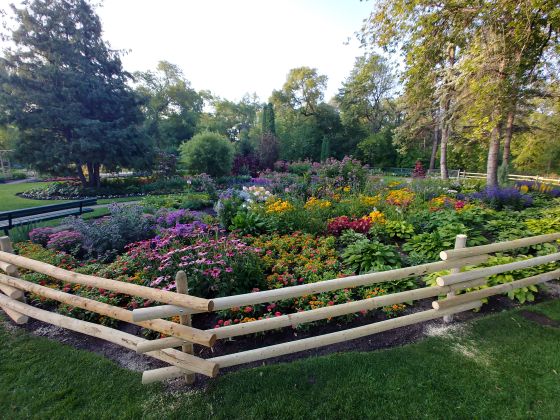
Kildonan Park’s flower bed in the north garden. (Alyssa Rempel photo)
Urban Retreats 2025 Garden Tour – Revisit the lovely gardens on display at this year’s Urban Retreats Garden Tour by watching this celebration video available on the 1JustCity YouTube channel.
Featuring the gardens of Deer Lodge, this year’s tour raised $35,000.00 for 1JustCity, a non-profit organization that supports three drop-in community centres in West Broadway, the West End, and Osborne Village.

An image from the virtual tour of the 2025 Urban Retreats Garden Tour (1JustCity)
Hydrangea breeding
Michael Perry is one of the most influential horticulturists today in the UK. Better known as Mr. Plant Geek, this intrepid plant lover travels the world in search of the newest and most fascinating plants.
Recently, Perry talked with Leo Slingerland, a breeding specialist at Living Creations Hydrangeas in Boskoop, Netherlands, which has been breeding hydrangeas for six generations.
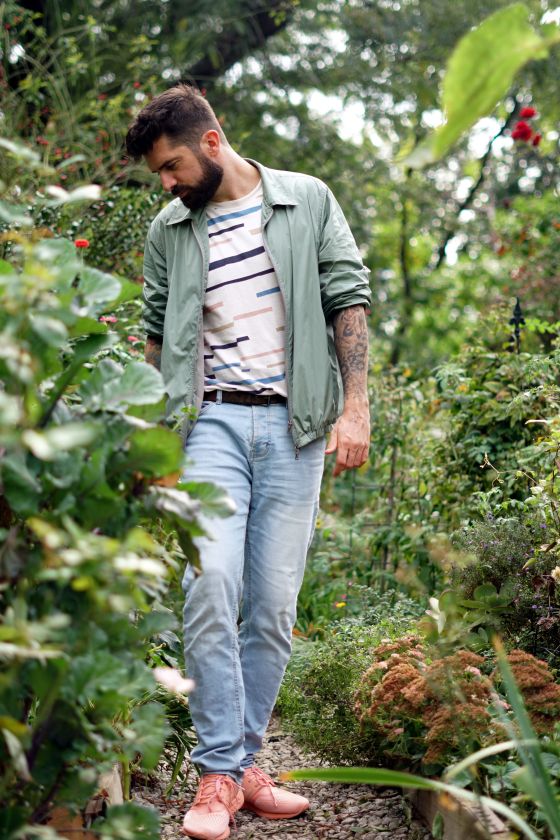
Michael Perry, a.k.a. Mr. Plant Geek. (Mr. Plant Geek photo)
In this video shared by Michael Perry on Instagram, Slingerland illustrates the breeding process to create new hydrangea varieties.
The process is not what you might expect!
The full interview with Slingerland is available on The Plant Based Podcast, a twice monthly podcast hosted by Perry.
A noteworthy nugget: The Living Creations hydrangea collection is currently being trialed at four locations in Ontario.
No word yet on when this new hydrangea collection will be available at local retail outlets; however, I’m excited to be currently trialing three of the collection’s new varieties in my garden.

Groundbreaker Blush Hydrangea (Living Creations Hydrangeas photo)
A compelling new hydrangea to look forward to from Living Creations Hydrangeas is the new Groundbreaker Blush, the world’s first-ever groundcover hydrangea bred by Alex Schoemaker.
A free streaming service
British Columbia’s Knowledge Network is an independent public educational broadcaster that operates free streaming services across Canada. No trials, no subscriptions, no commercials.
Choose from a diverse range of nature and environment-themed documentaries, including: How to Bee, Britain’s Novel Landscapes, Forest for the Trees, and more.
I’m currently watching The Secret History of the British Garden narrated by Monty Don. The music is beautiful, the visuals gorgeous, and the insights are fascinating.
How to edge flower beds and borders like a pro
I marvelled at the perfect edges along the beds and borders in Alyssa Rempel’s video of the North Garden at Kildonan Park. I asked Rempel, a graduate of the Greenspace Horticulture program at Red River College and a city gardener, if she would share the secrets of how to create perfect edges.
“If we need to redo or dig new edges, we use a tool called a half-moon edger,” said Rempel.
“Starting in the springtime and continually throughout the summer, we use an ice scraper to redo our edges weekly or biweekly. We then flip up the soil at an angle away from the edge and toss it into the bed.
“An essential tool for edging is a string line trimmer, also known as a weed whacker. This is used to horizontally trim the edges.
“But then we flip the cut portion of the turf to achieve a 90-degree vertical cut (the string should be rotating 90 degrees to the bed or lawn). This prevents the grass from growing into the bed and also prevents weeds from growing inside the edges or the bed.”
A gardening gift idea
Alla Olkhovska lives in Kharkiv, Ukraine. Despite the turmoil of the war that has destroyed parts of her city, she continues to garden and collect seeds from the many flowering plants that she grows.
She sells seeds for clematis, peonies, and phlox, as well as for rare plants and ships worldwide.
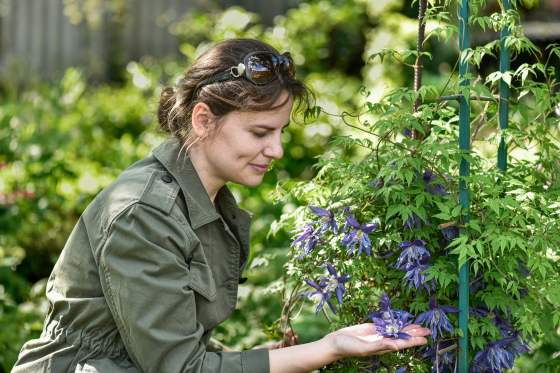
Alla Olkhovska in her garden in Ukraine with clematis (Alla Olkhovska photo)
Olkhovska is the author of two eBooks, Clematis and Clematis Passports.
Both eBooks were recently recommended by the International Clematis Society.
Her photography is stunning, and the detailed information is helpful to anyone who grows and loves clematis. Learn how to prune the different groups of clematis and how to propagate clematis from seed and through cuttings and layering.
Olkhovska was recently featured on BBC Gardeners World.
In 2023, Floret Farms created a documentary about Olkhovska and her garden. I wrote about the documentary in my column.
Olkhovska’s eBooks are available here.
Pre-order your copy of Manitoba Flora Volume 1
Manitoba Flora — A Guide to the Vascular Plants of Manitoba (Friesen Press Editions, 2025) is a new publication written by Diana Bizecki Robson, Curator of Botany at the Manitoba Museum. It covers 614 species of plants in Manitoba.
This important new book is the first flora of Manitoba published since the 1950s. It includes over 300 plant species documented in Manitoba since that time.
Learn to identify spore-producing plants (clubmosses, ferns, horsetails, quillworts, and spikemosses), along with conifers, and flowering monocots such as orchids, irises, lilies, grasses, and more.
Bizecki has compiled an authoritative guide that includes hundreds of illustrations, Indigenous names of culturally important plants, and a history of scientific and common plant names.
Detailed descriptions of plants include species’ rarity, ecological zones, habitats, and flowering periods.
Manitoba Flora is available in hardcover ($55.99), paperback ($45.99) or as an eBook ($20.99) through Friesen Press.
A limited number of copies are available to pre-order for the special price of $34.99. To pre-order your copy, please click here.
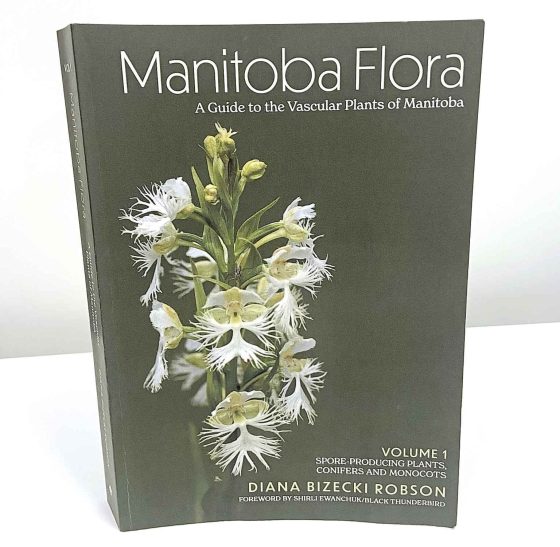
Manitoba Flora by Diana Bizecki Robson
Mark your calendars
- On Oct. 7 at 7 p.m., the West Kildonan Horticultural Society hosts the Annual Teacup Challenge and Houseplant Exchange at the West Kildonan Community Memorial Centre, 346 Perth Ave. This is a great opportunity to see WKHS members’ creative teacup designs and diverse houseplants. All are welcome. Doors open at 6:30 p.m. $5 entry. Bring a mug for coffee.
- On Oct. 14 at St. Mary Anglican Church, 3830 Roblin Blvd., the Charleswood Garden Club welcomes Ryan Maione, co-founder of Microbe Monastery, who will present on foraging and gardening with mushrooms. Doors open at 7 p.m. Refreshments will be available. All are welcome to attend.
- Compost Winnipeg’s fifth Annual Pumpkin Drop is expected to take place on Sunday, Nov. 2 at Polo Park Shopping Centre parkade from 10 a.m. to 3 p.m. Details are still being finalized and are subject to change. Visit Compost Winnipeg’s website to stay up-to-date.
- Do ghosts wander through the gardens at Assiniboine Park? Join the Winnipeg Paranormal Group at Assiniboine Park’s historic Pavilion, 55 Pavilion Crescent, for answers to some of your goosebump-inducing queries. The event begins with members of Assiniboine Park’s education team, who will detail the storied history of Assiniboine Park’s Pavilion and surrounding land. Register here for one of two sessions: Oct. 10 and Oct. 31 at 8 p.m. to 11 p.m. $55 plus GST.
- On Tuesday, Nov. 4, at 7 p.m., the Manitoba Master Gardener Association will host an online presentation, What Else Can a Garden Do – Exploring the Therapeutic Power of Plants by Melissa Scouten, education co-ordinator at the Assiniboine Park Conservancy. Join Melissa Scouten, a horticultural therapy practitioner, and discover how gardens and green spaces can do more than grow food and flowers. Register online here.
|

